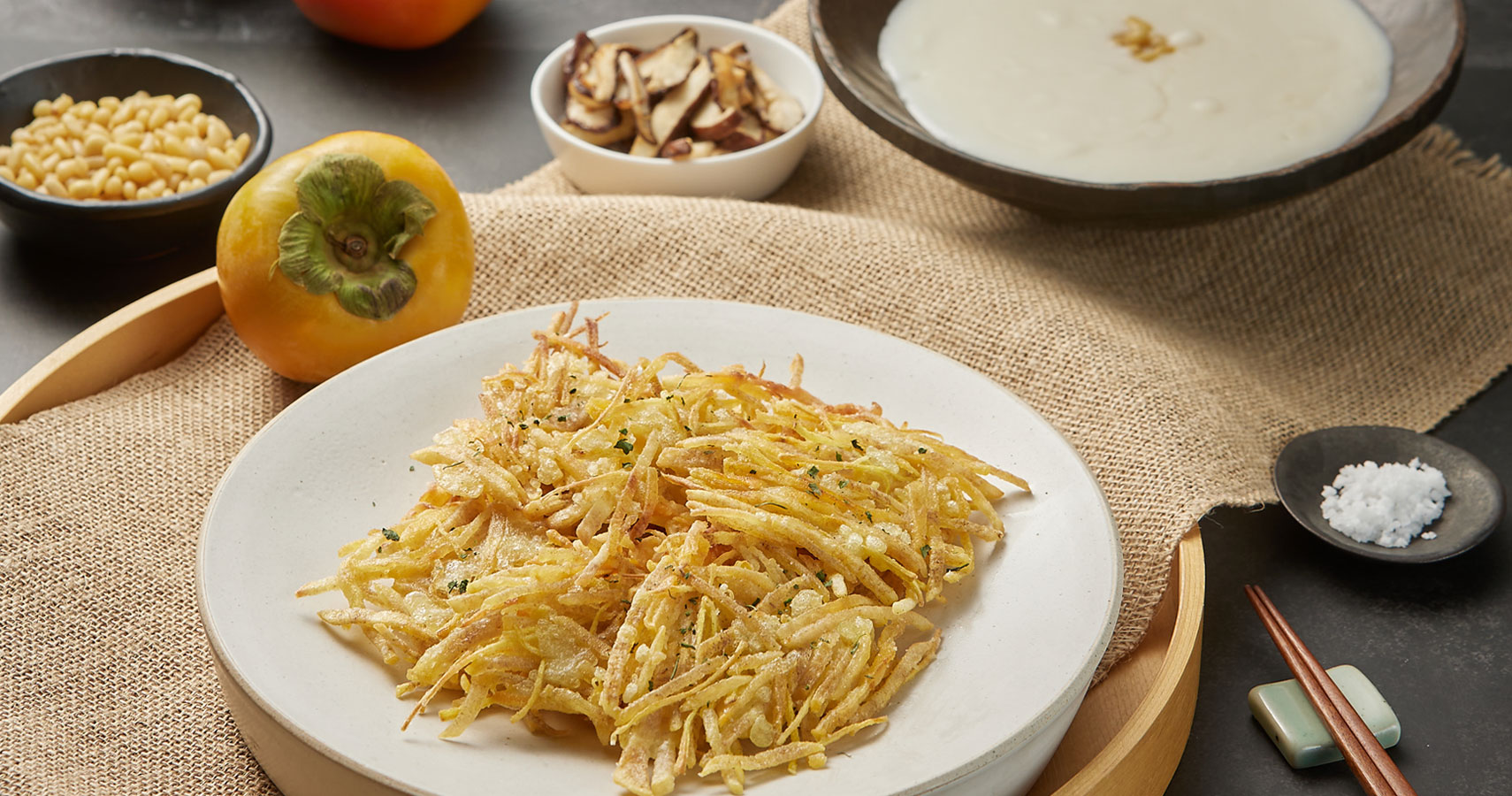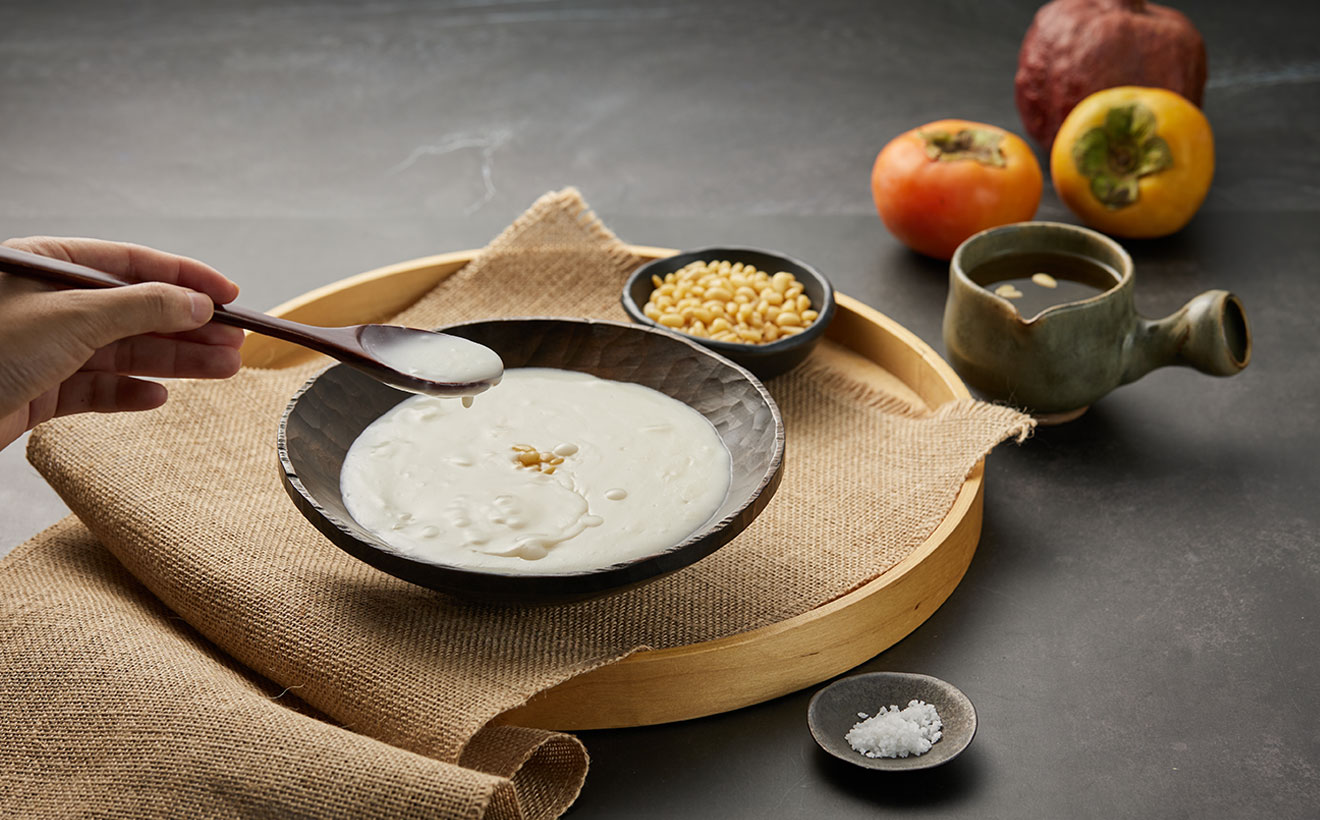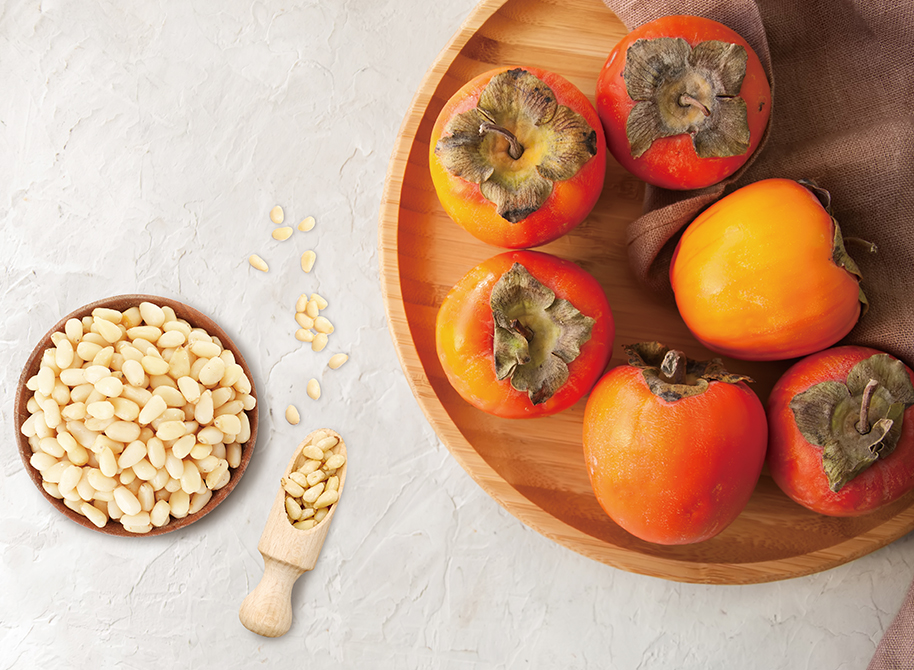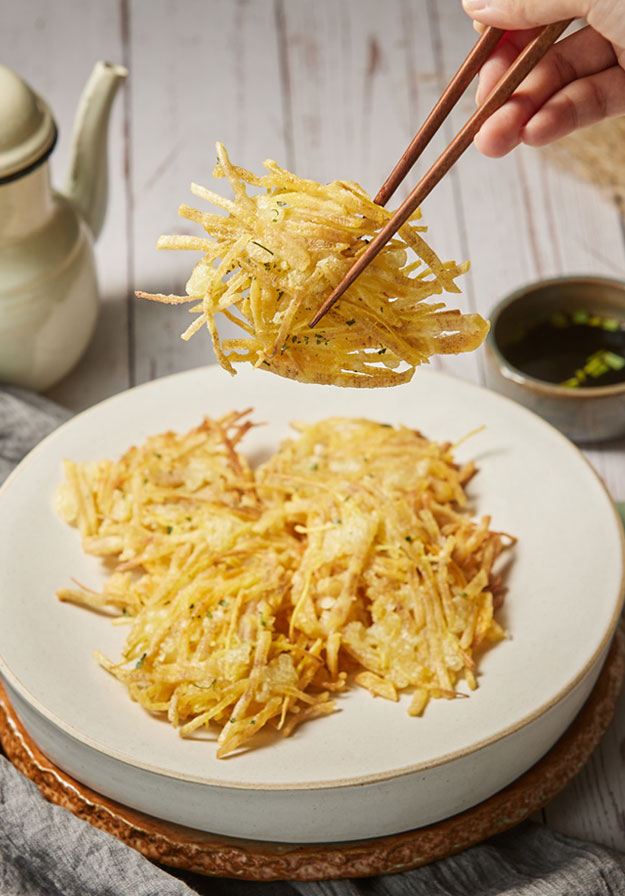November 2021

November 2021
Jatjuk or rice porridge with pine nuts may seem like an unlikely pairing with dangamjeon or savory persimmon pancakes. These dishes, however, feature signature fall staples that pack a nutritional knockout punch. That may be why Koreans over the centuries have loved these autumn flavors in both savory and sweet dishes.
Written by
Cynthia Yoo
contributing writer
Photographed by
Studio Kenn

Jat or pine nuts are popular the world over for their flavors and nutritional value. The ancient Romans prized their restorative powers so much that soldiers ate them as they prepared for battle. Koreans also treasure pine nuts as a delicacy and in fact, North Korea is one of the leading world producers. Pine nuts are renowned for their basket of antioxidants, including vitamins A, B, C, D and E. The fatty acid pinolenic acid found in pine nuts supports healthy cholesterol levels and even decreases appetite through the release of cholecystokinin, an appetite-suppressing hormone.
It’s no wonder that jatjuk was considered a rare delicacy in Korea, served to kings to relieve fatigue and fortify their constitution. By the time of the Silla Kingdom, there was a saying that three years of consuming jatjuk would lead one to become a sinseon or an immortal spirit because of its miraculous, medicinal properties. Along with Goryeo ginseng, jat was a highly-valued commodity, exported to China and the West. Today, pine nuts are still prized and the county of Gapyeong produces over 40% of the national total. Every October, residents of Gapyeong gather together in the foothills to harvest the seeds of the pine trees.
 Jatjuk is both nutritious and creamy.
Jatjuk is both nutritious and creamy.
While jatjuk is synonymous with fortifying the constitution of the weak, ill or elderly, it wouldn’t occur to many Koreans today to pair rice porridge with a dangamjeon or persimmon fritter pancakes. That would be a shame because these two dishes are a great fit in more ways than one. Jatjuk is a simple dish made of rice, water and pine nuts, and although many swear that it’s their favorite comfort food, the rice porridge tastes quite bland to many others. This is where the more complex texture and flavors of dangamjeon come into play. Persimmons present a mix of sweet and sometimes astringent flavors due to the tannins found in them. The textures also vary in different varieties of persimmons. While it’s crunchy on the outside, the center of the dangam boasts juicy honey-sweet flavors. Persimmons with its array of yellow and orange colors, can also provide a visual counterpoint to the pale white jatjuk.
Persimmons and pine nuts not only signal the fall harvest but they go wonderfully together in taste and nutritional value. On their own, persimmons are full of nutrients such as thiamin, magnesium and folate. Like pine nuts, persimmons are known for their antioxidant properties. Consuming one persimmon can take care of 55 percent of one’s daily recommended intake of vitamin A. Here, the fatty acids of the pine nut can help in the absorption of fat-soluble vitamins like vitamin A, D, E and K. Together, pine nuts and persimmons can pack a mean punch of antioxidants and vitamins, essential for building stamina and immunity as the weather chills down to flu season.
While jatjuk is synonymous with fortifying the constitution of the weak, ill or elderly, it wouldn’t occur to many Koreans today to pair rice porridge with a dangamjeon or persimmon fritter pancakes. That would be a shame because these two dishes are a great fit in more ways than one. Jatjuk is a simple dish made of rice, water and pine nuts, and although many swear that it’s their favorite comfort food, the rice porridge tastes quite bland to many others. This is where the more complex texture and flavors of dangamjeon come into play. Persimmons present a mix of sweet and sometimes astringent flavors due to the tannins found in them. The textures also vary in different varieties of persimmons. While it’s crunchy on the outside, the center of the dangam boasts juicy honey-sweet flavors. Persimmons with its array of yellow and orange colors, can also provide a visual counterpoint to the pale white jatjuk.
Persimmons and pine nuts not only signal the fall harvest but they go wonderfully together in taste and nutritional value. On their own, persimmons are full of nutrients such as thiamin, magnesium and folate. Like pine nuts, persimmons are known for their antioxidant properties. Consuming one persimmon can take care of 55 percent of one’s daily recommended intake of vitamin A. Here, the fatty acids of the pine nut can help in the absorption of fat-soluble vitamins like vitamin A, D, E and K. Together, pine nuts and persimmons can pack a mean punch of antioxidants and vitamins, essential for building stamina and immunity as the weather chills down to flu season.
 Pine nuts and persimmons are some of autumn’s tastiest delights. © Shutterstock
Pine nuts and persimmons are some of autumn’s tastiest delights. © Shutterstock
 Dangamjeon offers a crispy contrast to jatjuk.
Dangamjeon offers a crispy contrast to jatjuk.
Making jatjuk is a simple but laborious process. One key tip that’s not found in most recipes is to lightly fry the rice with sesame oil before simmering with pine nuts. Korean cooking expert Jung Seo-young says that this helps the grains retain their shape better and give them a texture that she describes as “still alive.” Others prefer to grind the soaked rice along with pine nuts to create an almost mieum-like (a very thin liquid) gruel that helps feed recovering patients or recently weaned children.
Dangamjeon requires less time and effort but still some attention to detail. It’s important to choose persimmons that are still firm to the touch but not unripened because the high levels of tannins will taste bitter and dry. The leafy green top of a ripened persimmon will pull off easily, but there shouldn’t be too much space between the leafy top and the rest of the fruit. The rest is easy. Slice the persimmons into julienne strips, add the strips into a store-bought pancake batter (buchim garu), and then fry dollops of the mixture in oil. Serve the persimmon fritters with a bowl of jatjuk, and you’re guaranteed of a nutritious and comforting meal fit for a king.